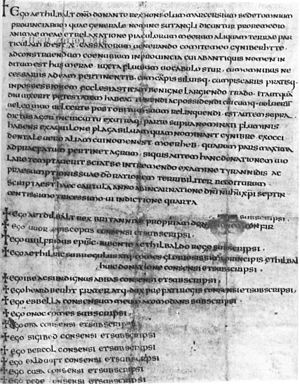Anglo-Saxon charters facts for kids
Anglo-Saxon charters were important documents from early medieval Britain. They were usually written on parchment, which is like a special animal skin paper, and mostly in Latin. These documents often recorded when someone was given land or a special right, like a privilege. They help us understand a lot about how people lived and how society worked over a thousand years ago.

Contents
Anglo-Saxon Charters: Ancient Documents of Britain
Anglo-Saxon charters are old written records from a time called the early Middle Ages in Britain. This was a period before the Norman Conquest in 1066. These special documents usually recorded important agreements. Most often, they were about giving away or confirming ownership of land. Sometimes, they also recorded special rights or "privileges" given to a person or a group.
What Were Anglo-Saxon Charters Made Of?
Most charters were written on parchment. Parchment is a strong material made from animal skin, like sheep or goat skin. It was carefully prepared to be smooth enough for writing. The main language used in these charters was Latin. Latin was the common language for important documents and learning across Europe at that time. Sometimes, a few words or phrases in Old English, the language spoken by the Anglo-Saxons, would also appear.
Why Were Charters So Important?
Charters were vital because they acted as legal proof. Imagine buying a house today; you get a deed to show you own it. Charters were similar for the Anglo-Saxons. They proved who owned a piece of land. This was very important because land meant wealth and power. Without a charter, it could be hard to prove your claim to land if someone challenged it. They also recorded special rights, like the right for a church to collect taxes or for a person to use a certain forest.
Who Used Anglo-Saxon Charters?
Kings were the main people who issued charters. They would grant land to their loyal followers, to important churches, or to monasteries. Powerful nobles and bishops also used charters to record their own land deals. These documents helped to keep track of who owned what in a time when there were no detailed maps or public land registries like we have today. They showed how power and wealth were shared in Anglo-Saxon society.
What Did Anglo-Saxon Charters Look Like?
Charters varied in size and appearance. They were usually a single sheet of parchment. Scribes, who were skilled writers, would carefully write the text. Sometimes, charters had beautiful decorations or special writing styles. Many charters also had a seal attached. A seal was a piece of wax pressed with a unique design, often belonging to the king or a powerful person. The seal acted like a signature, showing that the document was real and approved by the person who issued it.
How Do We Learn About Charters Today?
Many original Anglo-Saxon charters have survived over a thousand years. They were often kept safely in church or monastery libraries. Historians and scholars study these charters to learn about the past. They provide amazing details about Anglo-Saxon kings, nobles, and everyday life. We can learn about land ownership, laws, and even the names of places and people from long ago. Some charters are original, while others are copies made later. Both types help us understand this important period of British history.
Images for kids
-
Writ of King Edward the Confessor granting land at Perton in Staffordshire to Westminster Abbey, 1062–1066
-
Opening page of Alfred the Great's will drawn up circa 885 (11th-century copy)
-
A page from the charter of Edgar to the New Minster, Winchester. S 745. Unusually, the charter is in the form of a book.
See also
 In Spanish: Documentos anglosajones para niños
In Spanish: Documentos anglosajones para niños



